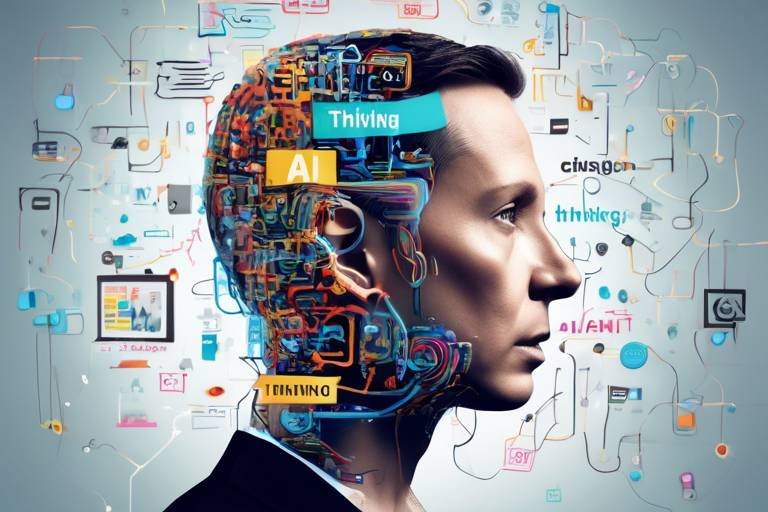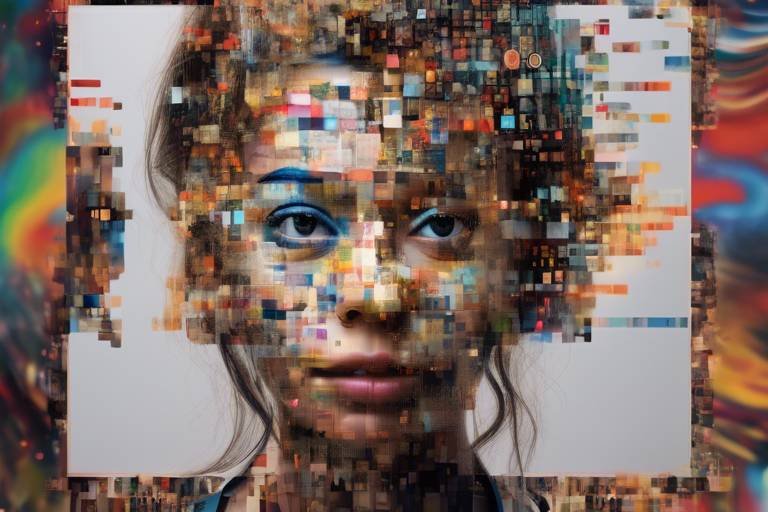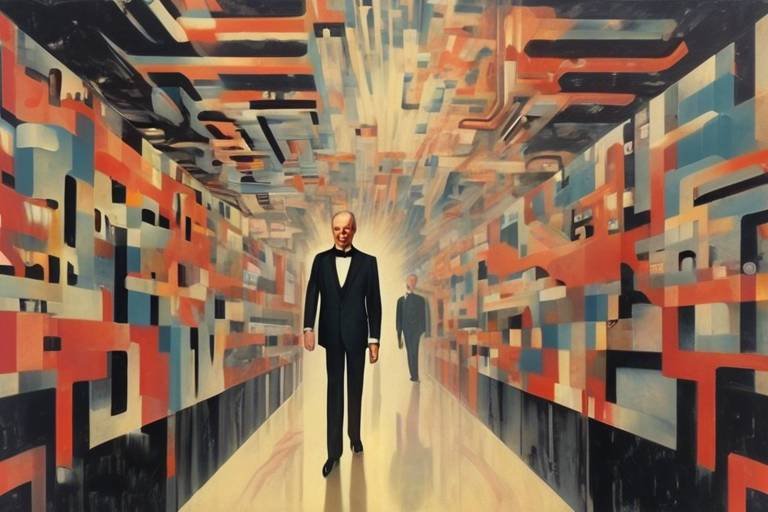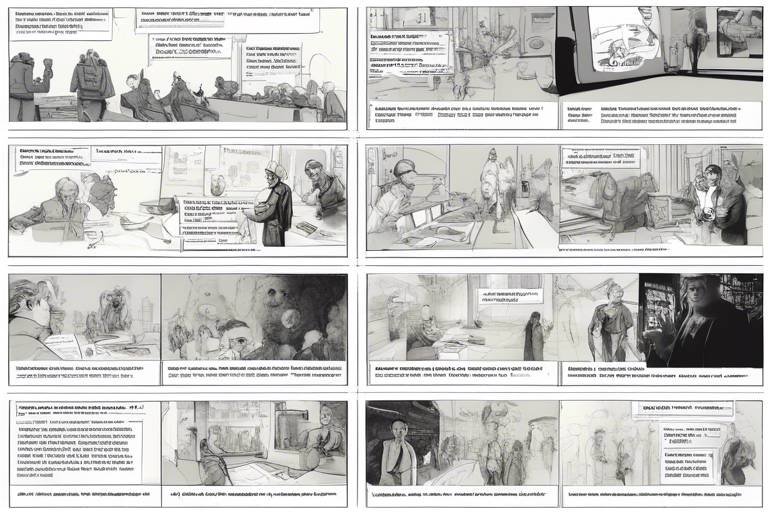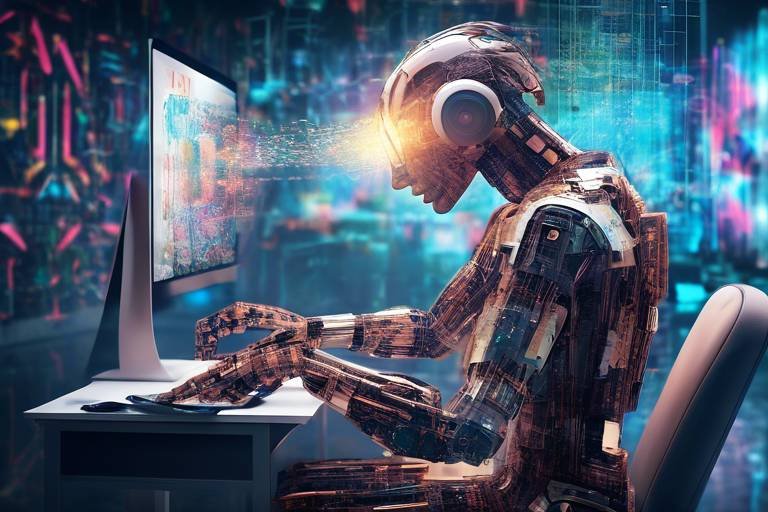How AI is Changing Design Thinking
In today's fast-paced world, the intersection of artificial intelligence and design thinking is creating waves like never before. Imagine a world where designers have a powerful ally that not only boosts their creativity but also streamlines their processes. This is the reality we are stepping into, as AI tools become integral in shaping the future of design. By harnessing the power of AI, designers can unlock new realms of innovation, efficiency, and user-centric solutions.
As we delve deeper into this topic, we will explore how AI is not just a tool but a transformative force in design thinking. It enhances the creative process, making it more efficient while also ensuring that user experiences are more personalized and satisfying. The blend of human creativity and machine learning is redefining what is possible in design, pushing boundaries and challenging traditional norms.
So, how exactly is AI changing the landscape of design thinking? Let's embark on this journey to understand the profound impact of AI on creativity, efficiency, and user experience. From generative design to AI-powered user research, we will uncover the ways in which designers are leveraging these technologies to create compelling and effective solutions.
Are you ready to explore how this technological revolution is reshaping the design world? Buckle up, because the future of design is not just about aesthetics—it's about creating meaningful experiences that resonate with users on a deeper level. Let’s dive in!

The Evolution of Design Thinking
Design thinking, at its core, is a human-centered approach to innovation that has evolved significantly over the years. Its origins can be traced back to the 1960s when it emerged as a way to solve complex problems through a structured process. Initially, it was primarily used in the fields of architecture and engineering, but as time went on, its principles began to permeate various disciplines, including business and education. The essence of design thinking lies in its focus on understanding the user, challenging assumptions, and redefining problems to identify alternative strategies and solutions.
At its foundation, design thinking is built upon five key principles:
- Empathy: Understanding the user's needs and experiences.
- Define: Clearly articulating the problem that needs solving.
- Ideate: Brainstorming a wide range of ideas and solutions.
- Prototype: Creating tangible representations of ideas to explore potential solutions.
- Test: Gathering feedback on prototypes to refine and improve solutions.
As we transitioned into the digital age, design thinking began to incorporate new technologies and methodologies, making it more accessible and effective. With the advent of artificial intelligence, the design thinking process has undergone a remarkable transformation. AI tools are now being integrated into each phase of the design process, enhancing traditional methods and allowing designers to work more efficiently and creatively. For instance, AI can analyze vast amounts of user data, providing insights that were previously unattainable. This integration not only improves the design process but also ensures that the end products are more aligned with user needs and expectations.
Furthermore, AI's ability to automate repetitive tasks has freed up designers to focus on what they do best: creative problem-solving. By taking over mundane tasks such as data entry or basic analysis, AI allows designers to invest more time in ideation and prototyping. This shift has led to a new wave of creativity, where designers can explore innovative solutions without being bogged down by the technicalities of the design process.
In conclusion, the evolution of design thinking reflects a broader trend towards interdisciplinary collaboration and the incorporation of advanced technologies. As we continue to embrace AI in design, we can expect even more profound changes that will push the boundaries of what is possible in the world of design. The future is bright, and the possibilities are endless!

AI Tools in the Design Process
In today's fast-paced world, AI tools are becoming essential companions for designers, revolutionizing the way they approach their work. Imagine having a virtual assistant that can not only handle mundane tasks but also inspire creativity! That’s exactly what AI brings to the table. From automating repetitive tasks to generating innovative design ideas, AI is reshaping the design landscape, making it more efficient and exciting.
One of the most significant advantages of integrating AI into the design process is the ability to streamline workflows. Designers often find themselves bogged down by time-consuming tasks such as resizing images, adjusting layouts, or even conducting user research. With AI tools, these processes can be automated, allowing designers to focus on what they do best: creating stunning visuals and engaging user experiences. For instance, tools like Adobe Sensei leverage AI to enhance design capabilities, making it easier to edit photos, create layouts, and optimize designs for various platforms.
Moreover, AI tools can assist in the ideation phase of design thinking. Imagine a scenario where you can input certain parameters and let an AI algorithm generate multiple design options for you. This is where tools like Canva's Magic Resize or Figma's AI Plugins come into play. They allow designers to explore a multitude of possibilities quickly and efficiently, pushing the boundaries of creativity. The ability to visualize different approaches helps in making more informed design decisions, ultimately leading to better outcomes.
While the benefits of AI tools are clear, it’s also essential to recognize the importance of understanding how to use them effectively. Just like any powerful tool, AI can be a double-edged sword. Designers must be trained to utilize these tools to their full potential, ensuring that they complement rather than replace human creativity. This balance is crucial, as it allows designers to maintain their unique voice while harnessing the efficiency that AI provides.
In conclusion, the integration of AI tools into the design process is not just a trend; it's a fundamental shift that enhances creativity and efficiency. As designers embrace these technologies, they unlock new avenues for innovation and user engagement. The future of design is undoubtedly bright, with AI as a guiding force, paving the way for more dynamic and personalized experiences.
- What are AI tools in design? AI tools in design refer to software applications that use artificial intelligence to assist designers in automating tasks, generating ideas, and enhancing creativity.
- How do AI tools improve efficiency? By automating repetitive tasks, AI tools free up designers to focus on more creative aspects of their work, thus improving overall efficiency.
- Are AI tools replacing human designers? No, AI tools are designed to assist and enhance human creativity, not replace it. They provide support that allows designers to explore more possibilities.
- What are some popular AI design tools? Some popular AI design tools include Adobe Sensei, Canva's Magic Resize, and Figma's AI Plugins.

Generative Design
Generative design is like having a supercharged brainstorming partner that never runs out of ideas. Imagine being able to input a few parameters—like materials, size, and budget—and then watching as an AI-powered system churns out countless design variations in a matter of seconds. This revolutionary approach is changing the game for designers, allowing them to explore a vast array of possibilities that would be nearly impossible to generate manually. By harnessing algorithms and computational power, generative design empowers creatives to push the boundaries of what's possible, leading to innovative solutions that can enhance both form and function.
At its core, generative design is about collaboration between human creativity and machine intelligence. Designers can set specific constraints and goals, and the AI generates multiple options that meet those criteria. For instance, in architectural design, a professional might specify the need for a structure that maximizes natural light while minimizing energy consumption. The generative design software would then analyze these parameters and produce various architectural models, each with unique features and layouts. This not only saves time but also opens doors to designs that might not have been considered otherwise.
However, it's essential to understand that generative design isn't just about producing a lot of options; it's also about enhancing the quality of those options. The technology uses advanced algorithms to evaluate and optimize the designs based on performance metrics. This means that designers can not only visualize different concepts but also compare their effectiveness in real-time. For example, a designer could assess how each generated model performs in terms of structural integrity, cost, and sustainability, allowing for informed decision-making.
One of the standout features of generative design is its ability to learn from previous iterations. As designers provide feedback on generated designs, the AI can refine its algorithms to produce even better results in the future. This iterative process creates a feedback loop that continuously enhances the design outcomes, making it a powerful tool for innovation.
In summary, generative design is a transformative technology that significantly expands the creative toolbox for designers. By combining human insight with machine learning, it offers a pathway to not only increase efficiency but also foster greater creativity. As this technology continues to evolve, we can expect to see even more groundbreaking designs emerge across various industries, from architecture to product design.

Benefits of Generative Design
Generative design is like having a creative partner that never sleeps! This innovative approach harnesses the power of algorithms to explore a vast array of design possibilities based on specific parameters set by the designer. One of the most significant benefits of generative design is the sheer increase in creativity. Designers can push boundaries and explore options they might not have considered, leading to groundbreaking solutions that truly stand out in the market.
Another major advantage is efficiency. Traditional design processes can be time-consuming, often requiring multiple iterations and revisions. Generative design streamlines this by quickly generating multiple variations, allowing designers to focus more on refining and enhancing the best options rather than getting bogged down in initial drafts. This not only saves time but also leads to a more productive workflow.
Moreover, generative design fosters collaboration. With AI handling the heavy lifting of generating designs, teams can engage in more meaningful discussions about aesthetics, functionality, and user needs. This collaborative spirit often results in designs that are not only innovative but also more aligned with user expectations. For example, a team can set parameters based on user feedback and let the algorithm propose designs that meet those needs, creating a synergy between technology and human insight.
To illustrate these benefits, consider the following table that summarizes key advantages:
| Benefit | Description |
|---|---|
| Increased Creativity | Generative design allows for a wider exploration of design options, leading to innovative solutions. |
| Enhanced Efficiency | Speeds up the design process by quickly generating multiple iterations based on set parameters. |
| Improved Collaboration | Fosters teamwork by allowing designers to focus on refining concepts rather than creating them from scratch. |
In addition to these benefits, generative design also encourages sustainability. By optimizing materials and manufacturing processes, designers can create products that are not only aesthetically pleasing but also environmentally friendly. This is crucial in today’s market where consumers are increasingly prioritizing sustainability in their purchasing decisions. In essence, generative design is not just about creating; it’s about creating responsibly.
In conclusion, the benefits of generative design extend far beyond mere aesthetics. It enhances creativity, boosts efficiency, encourages collaboration, and promotes sustainability. As designers embrace this technology, they open the door to a world of possibilities that can redefine what’s achievable in design thinking.
- What is generative design? Generative design is an iterative design process that uses algorithms to generate a wide range of design options based on specific constraints and parameters.
- How does generative design improve efficiency? By automating the generation of multiple design variations, generative design allows designers to focus on refining the best options instead of creating every iteration manually.
- Can generative design be used in all design fields? Yes! Generative design can be applied in various fields, including architecture, product design, and graphic design.
- Is generative design environmentally friendly? Yes, it can be! Generative design often optimizes material usage, which can lead to more sustainable products and manufacturing processes.

Challenges of Implementing Generative Design
Implementing generative design can feel like stepping into a whole new world of possibilities, but it’s not without its challenges. One of the most significant hurdles is the complexity of the technology itself. Generative design relies heavily on advanced algorithms and computational processes that can be daunting for many designers. It's like trying to learn a new language; at first, it seems overwhelming, but with practice, it becomes more intuitive.
Another challenge is the need for skilled users. While generative design tools can produce stunning results, they require a certain level of expertise to harness effectively. Designers must not only be proficient in traditional design principles but also in understanding how to set parameters and interpret the outputs generated by these tools. This dual skill set can create a steep learning curve, which may discourage some from fully embracing generative design.
Moreover, integrating generative design into existing workflows can be tricky. Many teams have established processes that may not easily accommodate new technologies. This resistance to change can lead to friction within teams, as members may feel uncertain about how to incorporate generative design into their projects. To ease this transition, open communication and training sessions can be invaluable. It's essential for teams to discuss their concerns and explore how generative design can complement their existing practices.
Additionally, there’s the issue of resource allocation. Generative design can be resource-intensive, requiring significant computational power and time. This can be a concern for smaller teams or companies with limited budgets. Investing in high-performance hardware or cloud computing services can alleviate some of these concerns, but it also raises questions about cost-effectiveness and return on investment.
Finally, designers must also navigate the ethical implications of using generative design. As algorithms take on more decision-making roles, there’s a risk of unintended biases creeping into the designs. This can lead to products that may not serve all users equally. Designers need to remain vigilant and ensure that their designs are inclusive and accessible, which adds another layer of responsibility to the generative design process.
In summary, while generative design holds incredible potential, it’s essential to approach its implementation with a clear understanding of the challenges involved. By addressing these issues head-on, designers can better leverage the advantages of generative design and create innovative solutions that push the boundaries of creativity.
- What is generative design? Generative design is a design process that uses algorithms to generate a wide range of design options based on specified parameters.
- What are the main challenges of generative design? The main challenges include complexity, the need for skilled users, integration into existing workflows, resource allocation, and ethical considerations.
- How can designers overcome these challenges? Designers can overcome challenges by investing in training, maintaining open communication, and ensuring ethical practices in their designs.

AI-Powered User Research
In the rapidly evolving landscape of design, is emerging as a game-changer. Traditional user research methods often involve tedious processes like surveys, interviews, and extensive data analysis, which can be time-consuming and sometimes yield incomplete insights. Enter AI, which is revolutionizing how designers gather and interpret user data. By harnessing the power of advanced algorithms and machine learning, AI tools can analyze vast amounts of data at lightning speed, providing designers with deeper insights into user behavior and preferences.
Imagine having a personal assistant that not only collects user feedback but also interprets it to reveal trends and patterns that may not be immediately obvious. AI tools can sift through user interactions, social media activity, and even customer support inquiries to paint a comprehensive picture of user needs. This process is akin to having a detective on your team, piecing together clues to solve the mystery of what users truly want.
One of the most exciting aspects of AI in user research is its ability to perform sentiment analysis. This technique allows designers to gauge user emotions and attitudes towards a product or service by analyzing textual data from reviews, comments, and social media posts. The insights gained from sentiment analysis can guide design decisions, ensuring that the end product resonates with users on a deeper emotional level.
Moreover, AI can facilitate real-time feedback during the design process. For instance, tools like user testing platforms can use AI to analyze how users interact with prototypes, identifying pain points and areas for improvement almost instantly. This immediate feedback loop not only saves time but also enhances the overall design quality by allowing for iterative adjustments based on actual user experiences.
In addition to sentiment analysis and real-time feedback, AI tools can also predict user needs by leveraging predictive analytics. By analyzing historical data and user behavior, these tools can forecast what users might prefer or require in the future. This foresight enables designers to create more intuitive and user-centric products, ultimately leading to higher user satisfaction and loyalty.
However, while the benefits of AI-powered user research are compelling, it's essential to recognize that it doesn't completely replace traditional methods. Instead, it complements them, providing a more holistic view of user needs. The combination of qualitative insights from traditional research and quantitative data from AI leads to a richer understanding of the user experience.
To summarize, AI-powered user research is not just a trend; it's a transformative approach that enhances how designers understand and cater to their audiences. By leveraging AI's capabilities, designers can make informed decisions that lead to more effective and engaging products. The future of design is undoubtedly intertwined with the advancements in AI, and embracing this technology will be crucial for those looking to stay ahead in the competitive design landscape.
- What is AI-powered user research? AI-powered user research involves using artificial intelligence tools to gather and analyze user data, providing deeper insights into user behavior and preferences.
- How does AI enhance traditional user research methods? AI complements traditional methods by offering faster data analysis, sentiment analysis, real-time feedback, and predictive analytics, leading to a more comprehensive understanding of users.
- Can AI replace human insight in user research? No, AI cannot replace human insight but rather enhances it. The best results come from combining qualitative insights from traditional methods with quantitative data from AI.
- What are some popular AI tools for user research? Some popular AI tools include UserTesting, Qualaroo, and Hotjar, which help in gathering user feedback and analyzing interactions.

Impact on User Experience
Artificial Intelligence (AI) is not just a buzzword; it’s a game-changer in the realm of user experience (UX). Imagine walking into a store where every item seems tailored just for you. That’s the magic of AI in design. By analyzing user behavior and preferences, AI can significantly enhance interactions, making them more intuitive and enjoyable. This shift from a one-size-fits-all approach to personalized experiences is revolutionizing how users engage with products and services.
One of the most profound impacts of AI on user experience is its ability to personalize interactions. For instance, think about how streaming services like Netflix or Spotify recommend shows and songs based on your viewing or listening history. This personalization not only makes the user feel valued but also increases engagement. Users are more likely to stick around when they feel like the service understands them. In fact, studies show that personalized experiences can lead to a up to 20% increase in user satisfaction.
Moreover, AI enhances usability by predicting user needs. Using predictive analytics, AI can analyze vast amounts of data to forecast what users might want or need next. This capability allows designers to create interfaces that are not only reactive but also proactive. For example, if a user frequently searches for specific types of products, an AI-driven platform might highlight those products in future visits, streamlining the shopping experience. This anticipatory design approach can significantly improve user satisfaction and reduce frustration.
Another fascinating aspect is how AI can learn from user interactions. By employing machine learning algorithms, AI systems can adapt and evolve based on user feedback and behavior patterns. This continuous improvement cycle means that user experiences can become more refined over time. Instead of static interfaces, users are treated to dynamic environments that grow smarter with each interaction. This adaptability can be likened to having a personal assistant who learns your preferences and becomes more effective at helping you over time.
However, it’s essential to recognize that while AI offers incredible opportunities, it also comes with challenges. For instance, the reliance on data can raise privacy concerns. Users are becoming increasingly aware of how their data is used, and transparency is key. Designers must balance personalization with privacy, ensuring that users feel safe and secure. Additionally, the complexity of AI systems can sometimes lead to confusion, particularly if the technology is not implemented thoughtfully. Therefore, it’s crucial for designers to keep the user at the center of the design process, ensuring that technology enhances rather than complicates the user experience.
In conclusion, the impact of AI on user experience is profound and multifaceted. By personalizing interactions and predicting user needs, AI is paving the way for more engaging and satisfying experiences. As designers continue to integrate AI into their processes, the focus should remain on creating intuitive, user-friendly designs that respect user privacy and foster trust. The future of user experience is bright, and AI is leading the charge.
- How does AI personalize user experiences? AI analyzes user data to tailor content, recommendations, and interfaces based on individual preferences.
- What role does predictive analytics play in design? Predictive analytics helps designers anticipate user needs and behaviors, enabling proactive design solutions.
- Are there privacy concerns with AI in user experience? Yes, as AI relies on user data, it’s crucial to ensure transparency and protect user privacy.
- Can AI improve usability? Absolutely! AI can simplify interfaces and streamline interactions, making them more intuitive for users.

Personalization Techniques
In today's digital landscape, personalization is no longer just a buzzword; it’s a fundamental aspect of user experience design. With the help of artificial intelligence, designers can create tailored experiences that resonate with individual users. But how exactly does this work? Well, think of personalization as a custom-made suit—it fits perfectly because it’s designed specifically for you, rather than a one-size-fits-all approach.
One of the most effective is the use of user data. By analyzing data gathered from user interactions, preferences, and behaviors, AI can help designers craft experiences that feel uniquely tailored. For instance, when you visit an e-commerce site, the recommendations you see are often based on your previous purchases and browsing history. This isn’t just luck; it’s AI at work!
Another technique involves dynamic content delivery. This means that the content a user sees can change based on various factors, such as their location, time of day, or even their device. Imagine visiting a news website, and depending on whether you access it from your phone or desktop, the layout and articles presented to you are different. This adaptability enhances engagement and keeps users coming back for more.
Moreover, AI can facilitate behavioral segmentation. By grouping users based on similar behaviors, designers can create targeted experiences that cater to specific segments. For example, a fitness app might offer different workout plans based on whether a user is a beginner or an experienced athlete. This kind of segmentation ensures that users receive relevant content, which increases satisfaction and engagement.
Lastly, leveraging predictive analytics can significantly enhance personalization efforts. By analyzing past user behavior, AI can predict what a user might be interested in next. This technique not only improves user experience but can also drive conversions. For example, if a user frequently browses running shoes, the site can proactively suggest new arrivals in that category before the user even thinks to look for them.
In summary, personalization techniques powered by AI are reshaping how users interact with digital products. By employing user data, dynamic content, behavioral segmentation, and predictive analytics, designers can create experiences that feel personal and engaging. The result? A more satisfied user base that feels valued and understood.
- What is personalization in design? Personalization in design refers to tailoring user experiences based on individual preferences, behaviors, and data.
- How does AI enhance personalization? AI enhances personalization by analyzing user data and predicting behaviors, allowing for customized content delivery.
- What are some examples of personalization techniques? Examples include dynamic content delivery, behavioral segmentation, and predictive analytics.
- Why is personalization important? Personalization is important because it improves user engagement and satisfaction, leading to higher retention rates.

Predictive Analytics in Design
Predictive analytics is reshaping the landscape of design thinking by enabling designers to anticipate user behavior and trends before they even occur. Imagine having a crystal ball that reveals what users might want or need in the future; that's essentially what predictive analytics offers. By leveraging vast amounts of data, AI algorithms can identify patterns and make predictions that inform design decisions. This not only enhances the creative process but also ensures that the final product resonates with users on a deeper level.
One of the most exciting aspects of predictive analytics in design is its ability to provide actionable insights. For instance, designers can analyze user interactions, feedback, and preferences to tailor experiences that feel personal and engaging. This capability is akin to having a personal stylist who knows your taste and can curate options just for you. With predictive analytics, designers can create solutions that not only meet current demands but also anticipate future needs, resulting in a more proactive approach to design.
Moreover, predictive analytics can significantly reduce the risk of design failure. By understanding potential user responses to various design elements, designers can make informed choices that align with user expectations. This is particularly valuable in industries where trends shift rapidly, such as fashion or technology. For example, a fashion designer might utilize predictive analytics to forecast which colors or styles will gain popularity in the upcoming season, allowing them to stay ahead of the curve.
However, it's important to note that while predictive analytics offers incredible benefits, it also comes with its challenges. The accuracy of predictions heavily relies on the quality and quantity of data collected. If the data is biased or insufficient, the predictions may lead designers astray. Therefore, it's crucial for designers to work closely with data scientists and analysts to ensure that they are interpreting data correctly. In this collaborative environment, designers can harness the full potential of predictive analytics, transforming raw data into valuable insights.
In conclusion, predictive analytics stands as a powerful tool in the arsenal of modern designers. By providing foresight into user behavior and preferences, it not only enhances creativity but also ensures that designs are relevant and impactful. As we continue to explore the intersection of AI and design thinking, the role of predictive analytics will undoubtedly grow, paving the way for more innovative and user-centric solutions.
- What is predictive analytics? Predictive analytics is a branch of advanced analytics that uses historical data, machine learning, and statistical algorithms to predict future outcomes.
- How does predictive analytics improve design? It helps designers anticipate user needs and preferences, allowing for more tailored and effective design solutions.
- What are the challenges of using predictive analytics in design? The main challenges include data quality, potential bias, and the need for collaboration between designers and data analysts.
- Can predictive analytics be used in all design fields? Yes, it can be applied in various fields such as fashion, technology, and user interface design to enhance the overall design process.
Frequently Asked Questions
- What is design thinking and how has it evolved?
Design thinking is a human-centered approach to innovation that emphasizes understanding user needs and iterative testing. Over the years, it has evolved from traditional design methods to incorporate new technologies, including artificial intelligence, which enhances creativity and efficiency in the design process.
- How is AI impacting the design process?
AI is revolutionizing the design process by automating repetitive tasks, analyzing data for insights, and providing innovative solutions. This allows designers to focus more on creativity and strategic thinking, ultimately leading to better design outcomes.
- What are some popular AI tools used in design?
Some popular AI tools in design include Adobe Sensei, Canva's Magic Resize, and Autodesk's generative design software. These tools help streamline workflows, enhance creativity, and provide valuable data insights that inform design decisions.
- What is generative design and why is it beneficial?
Generative design is a process that uses algorithms to generate a multitude of design options based on specific input parameters. This approach empowers designers to explore a wider range of possibilities, leading to increased creativity and more efficient solutions.
- What challenges might designers face when implementing generative design?
While generative design offers many benefits, it can also pose challenges such as complexity and the need for skilled users. Designers may need to invest time in learning how to use these advanced tools effectively to overcome these hurdles.
- How does AI enhance user research?
AI enhances user research by analyzing large sets of data to uncover deeper insights about user behavior and preferences. This information helps designers create more user-centric products that meet the actual needs of their audience.
- In what ways does AI improve user experience?
AI improves user experience through personalization and predictive analytics. By tailoring interactions to individual users and anticipating their needs, AI creates more engaging and satisfying experiences, ultimately leading to higher user retention and loyalty.
- What are personalization techniques in AI design?
Personalization techniques in AI design include recommendation systems, adaptive interfaces, and user behavior tracking. These methods allow designers to create tailored experiences that resonate with users on a personal level, enhancing engagement and satisfaction.
- How does predictive analytics play a role in design thinking?
Predictive analytics uses AI to analyze data and forecast user behavior and trends. This information aids designers in making informed decisions, ensuring that their designs not only meet current user needs but also anticipate future demands.

